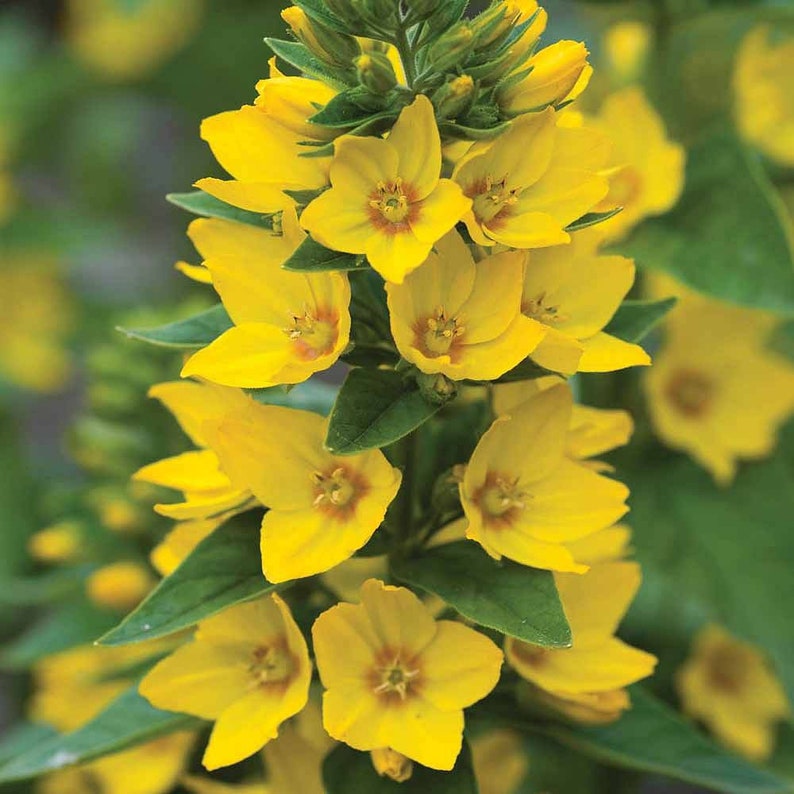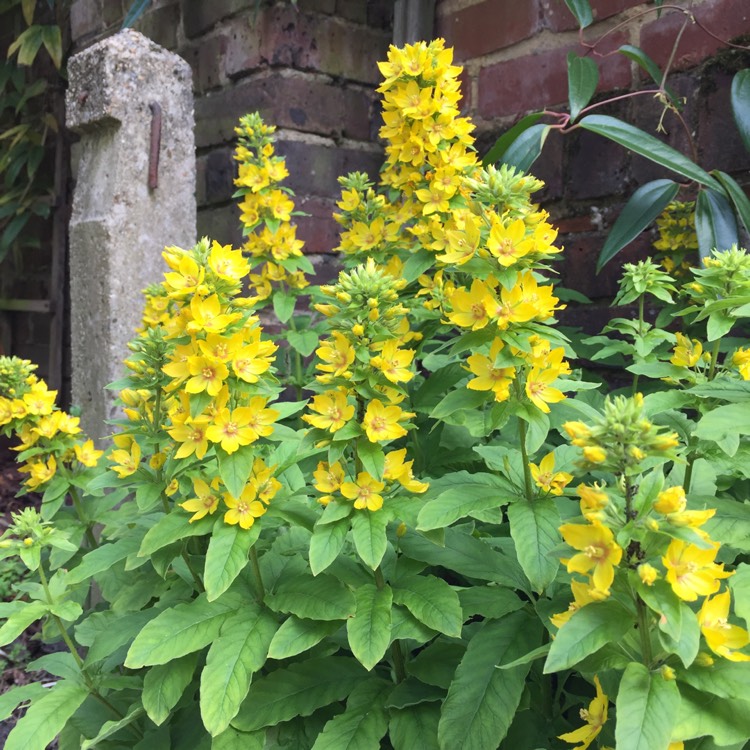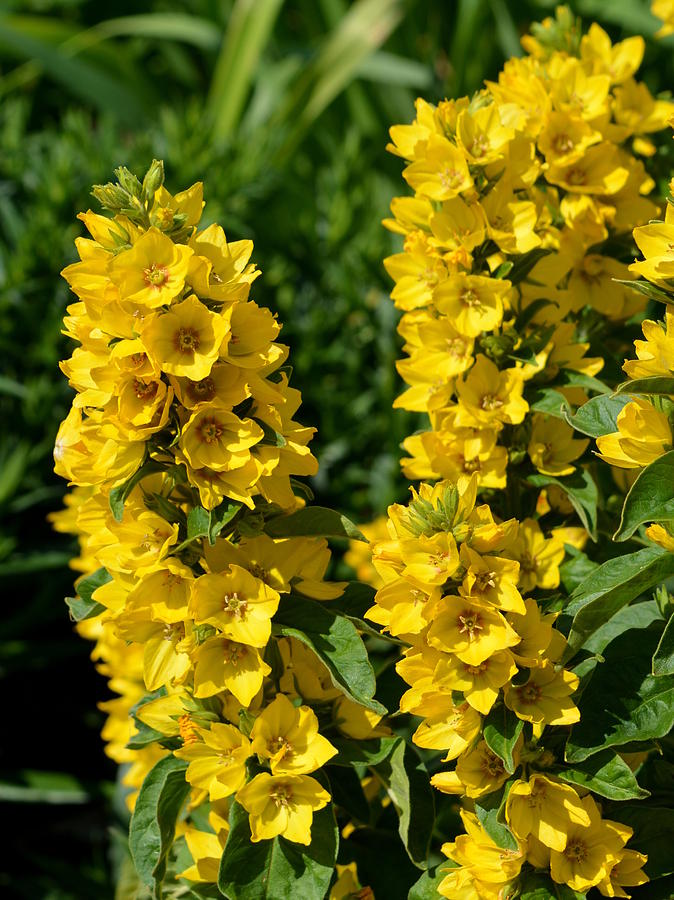To be a good gardener you need knowledge, time, money and enthusiasm. Lysimachia L. Punctata
Yellow Loosestrife Fact Sheet: PLANT TYPE Herbaceous Perennial HARDINESS ZONES USDA 4 - 8 LIGHT REQUIREMENTS Full sun BLOOM COLOR Yellow, orange BLOOM PERIOD June - September (Summer) MAXIMUM GROWTH Height between 45.72-91.44 cm (18-36 in.), large potential spread PLANTING DEPTH Place seeds ¼ inch below soil surface; bury mature plants to crown

Lysimachia punctata (large yellowloosestrife) Go Botany
Much less aggressive than the species, Lysimachia punctata 'Alexander' (Yellow Loosestrife) is a perennial plant with stunning ornamental value, producing sturdy, upright stems loaded with striking variegated foliage consisting of whorls of lime green serrated leaves with bright creamy edges that emerge with a pink blush in spring and age to white.

Large Yellow Loosestrife 10 seeds Lysimachia punctata Etsy
Large yellow loosestrife is native to Europe and occasionally escapes from cultivation in North America. Habitat Anthropogenic (man-made or disturbed habitats ), meadows and fields Characteristics Habitat terrestrial New England state Connecticut Maine Massachusetts New Hampshire Vermont Flower petal color yellow Leaf type

Lysimachia punctata (large yellowloosestrife) Go Botany
Loosestrife ( Lysimachia spp.) is a large plant family with more than 180 species of herbaceous and evergreen perennials. Types vary from stately plants suitable for borders to ones that serve as creeping groundcovers. Flowers vary, too; they can be shaped like cups, saucers, or stars and come in shades of white, yellow, pink, and purple.

Large Yellow Loosestrife Lysimachia punctata Dan Mullen Flickr
Garden yellow loosestrife. Common Names: Garden loosestrife. Description: Can be distinguished from relative natives by its red-margined calyx. Habit: Herbaceous perennial reaching 1 m (3.25 ft) in height, with long rhizomes that can extend 10 m (33 ft). Leaves: Whorled or opposite, lanceolate with hairs and small glands below, dotted.

Large Yellow Loosestrife stock photo. Image of dotted 163461182
Characteristics Habitat terrestrial New England state Connecticut Maine Massachusetts New Hampshire Rhode Island Vermont Flower petal color pink to red yellow Leaf type the leaves are simple (i.e., lobed or unlobed but not separated into leaflets ) Leaf arrangement

Large Yellow Loosestrife Lysimachia punctata Dan Mullen Flickr
Yellow Loosestrife (Lysimachia punctata), also known as Dotted Loosestrife, is a flowering plant species native to Europe and parts of Asia. It belongs to the family Primulaceae. Yellow Loosestrife is a herbaceous perennial plant that typically grows to a height of about 1 to 3 feet (30 to 90 centimeters).

Yellow loosestrife hires stock photography and images Alamy
(Lysimachia vulgaris) Photo credit: Leslie J. Mehrhoff, University of Connecticut, Bugwood.org Herbaceous perennial wetland invader with yellow flowers. Closely related to the aggressive invasive plant, purple loosestrife. Restricted (orange) counties Other names for this plant include: Common names: garden loosestrife, willowweed, and willowwort

Lysimachia punctata (large yellowloosestrife) Go Botany
Size: 3-4 feet Native Range: From southeast Europe to the Caucasus (Stace, 2010). This species is not currently in the Great Lakes region but may be elsewhere in the US. See the point map for details. Table 1.

Yellow Loosestrife (Lysimachia punctata); a mellow yellow perennial in the Plant ID forum
L. vulgaris is a hairy perennial that forms clumps by creeping stolons or rhizomes. Leaves are ovate, green, sometimes with black dots, and occur in groups of three or four. Yellow flowers are borne in terminal clusters in summer Other common names common loosestrife golden loosestrife see more golden willowherb Join the RHS today and save 25%

Lysimachia punctata (large yellowloosestrife) Go Botany
Description Dotted loosestrife is an herbaceous, perennial flower in the Primulaceae (primrose) family. It is native to Asia and southern/central Europe. It was introduced into North America for ornamental gardens but has naturalized widely in the U.S. and Canada in damp, sunny areas such as ditches, meadows, roadsides and stream banks.

Large Yellow Loosestrife 10 seeds Lysimachia punctata Etsy
Lysimachia punctata, the dotted loosestrife, [1] large yellow loosestrife, [2] circle flower, [3] or spotted loosestrife, is a flowering plant species in the family Primulaceae . Description Lysimachia punctata is a rhizomatous perennial herbaceous plant growing up to about 1.2m in height.

Lysimachia punctata, Large Yellow Loosestrife uploaded by justin
Description Yellow loosestrife is a tall downy semi-evergreen perennial plant with an upright habit, 50-150 centimetres (20-59 in) high, with erect panicles of conspicuous yellow flowers. [5] : 519 The edges of the petals lack the fringe of hairs seen in L. punctata, and the hairy, narrow triangular sepals have a conspicuous orange margin.

Dotted loosestrife, Large yellow loosestrife, Spotted loosestrife 900 seeds Garden Seeds
Creeping Charlie, Creeping Jenny, Yellow Loosestrife, and Moneywort: Cultivation & Garden Use. Members of the Lysimachia plant genus are usually upright hardy perennials. They usually reach from 30 to 90 cm (1 to 3 feet) in height.. Lysimachia punctata (Dotted Loosestrife / Large Yellow Loosestrife / Circle Flower), photograph by Tim Green; CC.

Large yellow loosestrife at Svanfoss, Beautiful, but not wanted Beautiful, Plants, Yellow
Named after the Macedonian King of Thrace (Lysimachus), Lysimachia punctata (Yellow Loosestrife) is a perennial plant with great ornamental value, producing sturdy, upright stems loaded with abundant spikes of cup-shaped, golden yellow flowers, tinged with red at their heart.

Yellow Loosestrife Photograph by Ed Mosier
Native to Europe and the Middle East, variegated lysimachia is a herbaceous perennial that boasts striped foliage and striking yellow flowers. Best planted in the fall, it grows slowly, forming clumps with tall stalk-like stems that can reach up to 3 feet tall.